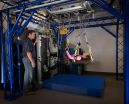(Press-News.org) (SACRAMENTO, Calif.) -- Many of those who should get it, don't. And many of those who shouldn't, do. That's the story of a common screening test for osteoporosis, according to new research from UC Davis Health System.
The study, published online today in the Journal of General Internal Medicine, found that screening rates increased sharply among women at age 50, despite guidelines suggesting screening at age 65 unless risk factors are present. The presence of risk factors only had a modest influence on screening decisions.
Osteoporosis causes bone density to diminish and fracture risk to increase. Because gender and age are factors most associated with the disease, the U.S. Preventive Services Task Force recommends screening for women who are age 65 and older. Younger women with certain risk factors -- such as a small body frame, a history of fractures or taking medication that thins the bones -- should also be screened.
As part of a UC Davis research fellowship, physician Anna Lee Amarnath assessed the electronic health records of nearly 51,000 women who were between the ages of 40 and 85 and received health care in the Sacramento region. Her evaluation included osteoporosis risk factors and whether or not the women received a screening technique called dual-energy X-ray absorptiometry (DXA), which measures bone mineral density.
Over a seven-year period, more than 42 percent of eligible women between the ages of 65 and 74 years were not screened, nor were nearly 57 percent of those older than 75, despite the favorable cost-effectiveness of screening in these age groups. In turn, nearly 46 percent of low-risk women between the ages of 50 and 59 were screened, as were 59 percent of those aged 60 to 64 years without risk factors.
"DXA screening was underused in women at increased fracture risk, including women aged 65 years and older. Meanwhile, it was common among women at low fracture risk, such as younger women without osteoporosis risk factors," Amarnath said, in summarizing the findings.
Amarnath and the study team believe they have identified a common problem, since health care providers can be uncertain or doubtful about current screening recommendations. Doctors tend to think about age-related bone loss when women enter menopause around age 50, triggering consideration of DXA without also considering overall facture risk.
Technology-based solutions could help, according to study senior author Joshua Fenton.
"Health systems should invest in developing electronic health records systems that prompt providers at the point-of-care when screening is needed and when it can be postponed," said Fenton, a UC Davis associate professor of family and community medicine.
INFORMATION:
In addition to Amarnath and Fenton, study authors were Peter Franks, John Robbins and Guibo Xing of UC Davis. Their work was supported by grants from the National Institutes of Health to the UC Davis Clinical and Translational Science Center (UL1TR000002) and the Agency for Healthcare Research and Quality (T32HS022236).
A copy of "Underuse and Overuse of Osteoporosis Screening in a Regional Health System: a Retrospective Cohort Study" is available at http://link.springer.com/article/10.1007/s11606-015-3349-8
More information about the Journal of General Internal Medicine, published by Springer, is at http://link.springer.com/journal/11606
More information about UC Davis Health System and its Department of Family and Community Medicine is at http://healthsystem.ucdavis.edu.
A dramatic video has captured the behaviour of cytotoxic T cells - the body's 'serial killers' - as they hunt down and eliminate cancer cells before moving on to their next target.
In a study published today in the journal Immunity, a collaboration of researchers from the UK and the USA, led by Professor Gillian Griffiths at the University of Cambridge, describe how specialised members of our white blood cells known as cytotoxic T cells destroy tumour cells and virally-infected cells. Using state-of-the-art imaging techniques, the research team, with funding from the ...
Decades' worth of textbook precepts about how our immune systems manage to avoid attacking our own tissues may be wrong.
Contradicting a long-held belief that self-reactive immune cells are weeded out early in life in an organ called the thymus, a new study by Stanford University School of Medicine scientists has revealed that vast numbers of these cells remain in circulation well into adulthood.
"This overturns 25 years of what we've been teaching," said Mark Davis, PhD, professor of microbiology and immunology and director of Stanford's Institute for Immunity, Transplantation ...
Scientists are reporting development of a new way to modify interleukin-2 (IL-2), a substance known as a cytokine that plays key roles in regulating immune system responses, in order to fine-tune its actions. Harnessing the action of IL-2 in a controllable fashion is of clinical interest with potential benefit in a range of situations, including transplantation and autoimmune disease. The modified IL-2 molecules inhibited the actions of endogenous IL-2, potentially more effectively than existing agents, as well as inhibited the actions of another interleukin, IL-15, with ...
A team led by researchers from Massachusetts General Hospital (MGH) and the Ragon Institute of MGH, MIT and Harvard has found that the most common bacterial community in the genital tract among healthy South Africa women not only is significantly different from that of women in developed countries but also leads to elevated levels of inflammatory proteins. In a paper in the May 19 issue of Immunity, the investigators describe finding potential mechanisms by which particular bacterial species induce inflammation and show that the presence of those species and of elevated ...
Ever since single-layer graphene burst onto the science scene in 2004, the possibilities for the promising material have seemed nearly endless. With its high electrical conductivity, ability to store energy, and ultra-strong and lightweight structure, graphene has potential for many applications in electronics, energy, the environment, and even medicine.
Now a team of Northwestern University researchers has found a way to print three-dimensional structures with graphene nanoflakes. The fast and efficient method could open up new opportunities for using graphene printed ...
HIV infections continue to rise in a new generation of young, gay, bisexual and other men who have sex with men (YMSM) despite three decades of HIV prevention as well as recent availability of biomedical technologies to prevent infection. In the U.S., it is estimated that 63% of incident HIV infections in 2010 were among YMSM despite the fact that they represent a very small portion of the population. Given this heightened risk for HIV seroconversion among YMSM, researchers at New York University's Center for Health, Identity, Behavior & Prevention Studies (CHIBPS) sought ...
ANN ARBOR, Mich. -- Why do some cancer cells break away from a tumor and travel to distant parts of the body? A team of oncologists and engineers from the University of Michigan teamed up to help understand this crucial question.
Cancer becomes deadly when it spreads, or metastasizes. Not all cells have the same ability to travel through the body, but researchers don't understand why.
In a paper published in Scientific Reports, researchers describe a new device that is able to sort cells based on their ability to move. The researchers were then able to take the sorted ...
Run far or run fast? That is one of the questions NASA is trying to answer with one of its latest studies--and the answers may help keep us in shape on Earth, as well as in space. Even with regular exercise, astronauts who spend an extended period of time in space experience muscle weakening, bone loss, and decreased cardiovascular conditioning. This is because they no longer have to work against gravity in everyday living.
NASA's Human Research Program Integrated Resistance and Aerobic Training study, known as iRAT, completed recently to evaluate the use of high intensity ...
Human error is estimated to cause more than 90% of traffic accidents, a percentage that might be drastically reduced by the implementation of self-driving cars featuring smart systems that control most aspects of driving. Although the potential benefits of self-driving cars have been widely touted, their success on the roadways of the near future is largely reliant on whether or not drivers are willing to trust these smart systems enough to hand over the wheel. A new study published in Human Factors: The Journal of the Human Factors and Ergonomics Society evaluated whether ...
A University of Colorado Cancer Center study published in the journal Nicotine & Tobacco Research shows a new dimension to the marginalization of smokers: people who smoke are less likely to vote than their non-smoking peers.
"One on hand, the result is intuitive. We know from previous research that smokers are an increasingly marginalized population, involved in fewer organizations and activities and with less interpersonal trust than nonsmokers. But what our research suggests is that this marginalization may also extend beyond the interpersonal level to attitudes toward ...


